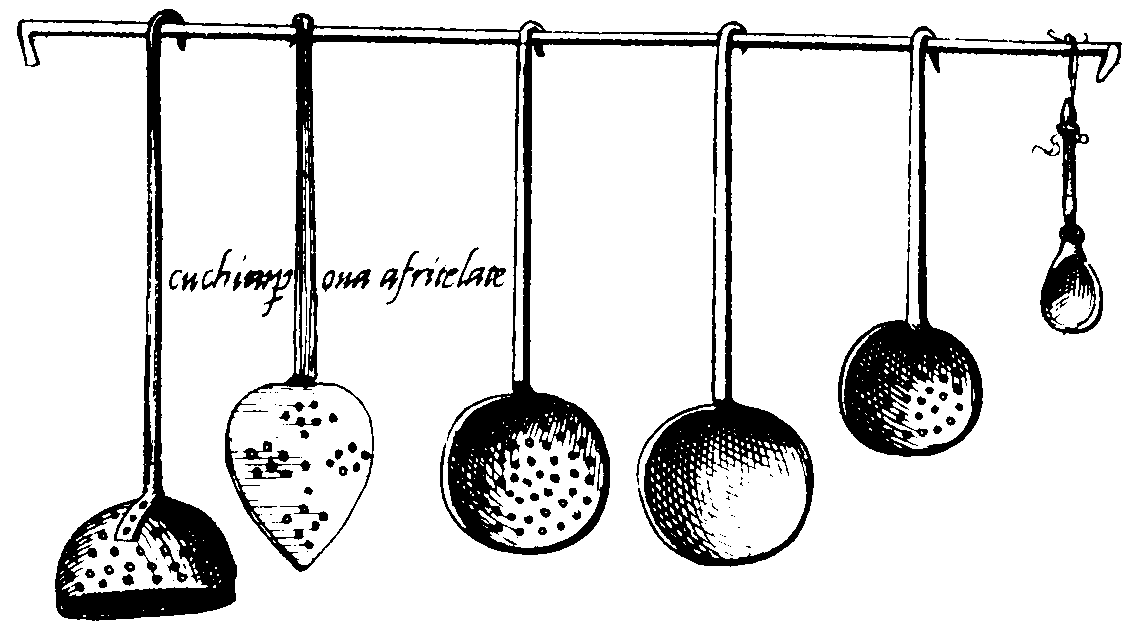The Kitchen
 The oven was rather primitive, as
it was mere a concealed space that could be heated. It was mostly constructed
of stone, since metal is rare and more expensive. During the Middle Ages,
often people would still use heated stones to bake, as the oven was not
much more efficient. Also, the cooks of the medieval period liked to take
advantage of the hot ashes left from a burning fire. Often, they would
bury food in the ash, using the heat to conduct small scaled baking.
The oven was rather primitive, as
it was mere a concealed space that could be heated. It was mostly constructed
of stone, since metal is rare and more expensive. During the Middle Ages,
often people would still use heated stones to bake, as the oven was not
much more efficient. Also, the cooks of the medieval period liked to take
advantage of the hot ashes left from a burning fire. Often, they would
bury food in the ash, using the heat to conduct small scaled baking.

Over the open fire, there would usually
be a spit, which is a long metal stick that could be revolved manually.
Animals could be secured on the spit, and revolved to ensure that it was
cooked evenly. In addition to the spit, an adjustable hook also overhangs
the fire. Large cauldrons could be hooked into place over the fire, in
which most of the food was cooked. The amount of heat desired by the cook
could be adjusted simply by moving the hook, closer to the fire to increase
heat and further away to decrease the heat.
 Near
the kitchen, a larder usually resided. The larder is a room in which food
was stored, and at times, wine and other alcoholic drinks was also stored.
Much of the meat is hanged in the larder, to prevent from being eaten by
bugs and other animals, regardless of the method of which they were preserved.
The collection of meat consisted of domesticated farm animals such as lambs,
pork, and beef, to wild birds, rabbits, ducks, pigeons, and boars. Occasionally,
even swans, herons and crows would also be added to the collection.
Near
the kitchen, a larder usually resided. The larder is a room in which food
was stored, and at times, wine and other alcoholic drinks was also stored.
Much of the meat is hanged in the larder, to prevent from being eaten by
bugs and other animals, regardless of the method of which they were preserved.
The collection of meat consisted of domesticated farm animals such as lambs,
pork, and beef, to wild birds, rabbits, ducks, pigeons, and boars. Occasionally,
even swans, herons and crows would also be added to the collection.
|
|
 The oven was rather primitive, as
it was mere a concealed space that could be heated. It was mostly constructed
of stone, since metal is rare and more expensive. During the Middle Ages,
often people would still use heated stones to bake, as the oven was not
much more efficient. Also, the cooks of the medieval period liked to take
advantage of the hot ashes left from a burning fire. Often, they would
bury food in the ash, using the heat to conduct small scaled baking.
The oven was rather primitive, as
it was mere a concealed space that could be heated. It was mostly constructed
of stone, since metal is rare and more expensive. During the Middle Ages,
often people would still use heated stones to bake, as the oven was not
much more efficient. Also, the cooks of the medieval period liked to take
advantage of the hot ashes left from a burning fire. Often, they would
bury food in the ash, using the heat to conduct small scaled baking.

 Near
the kitchen, a larder usually resided. The larder is a room in which food
was stored, and at times, wine and other alcoholic drinks was also stored.
Much of the meat is hanged in the larder, to prevent from being eaten by
bugs and other animals, regardless of the method of which they were preserved.
The collection of meat consisted of domesticated farm animals such as lambs,
pork, and beef, to wild birds, rabbits, ducks, pigeons, and boars. Occasionally,
even swans, herons and crows would also be added to the collection.
Near
the kitchen, a larder usually resided. The larder is a room in which food
was stored, and at times, wine and other alcoholic drinks was also stored.
Much of the meat is hanged in the larder, to prevent from being eaten by
bugs and other animals, regardless of the method of which they were preserved.
The collection of meat consisted of domesticated farm animals such as lambs,
pork, and beef, to wild birds, rabbits, ducks, pigeons, and boars. Occasionally,
even swans, herons and crows would also be added to the collection.